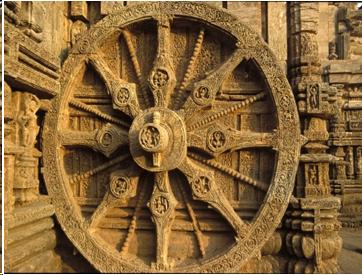
Hinduism's Main Tenets (developed during the Vedic Period)

An anonymous Hindu Wheel of Life
By the time of the Upanishads (ca. 600 BCE) the basic beliefs of Hinduism had undergone a basic, incredibly important transition, influenced by local, non-Aryan culture (that is, these basic tenets which have blended with Vedic belief seem to have been developed by the original inhabitants of India, the Dravidians). Hindus now believed that all gods emanated, or came from, and were part of a single ultimate reality. This kind of religious belief is known as monism (not to be confused with monotheism!), and means that there can be many gods but all come from the same source and are part of it (that is, Hinduism remains polytheistic, but tops the gods with an ultimate being). Known as Brahman (The One or The Absolute), this single entity was everything; everything was of it, in it, and from it. A part of Brahman which has become separated from it is the Atman, or the individual soul of each human. In this view, the desire of the atman, its sole aim actually, is to be reunited with Brahman, to become The One again, to be everything again (since going back to Brahman necessarily means becoming part of the ultimate all). This reunion, the end-all and be-all of Hinduism, is called Moksha. How, exactly, is the individual soul to be reunited with The One? According to Hindu belief, the soul needs to escape Samsara, or the wheel of life. Samsara consists of many lives, and is a continuous circle which links all kinds of existence, from worms and insects to gods. Closely tied to the idea of Samsara is the concept of reincarnation, or the belief in recurring lives. Reincarnation is the returning of the soul to life after its death, in a different life: possibly a different social position, family, profession, even a different form altogether. The notion is that the soul progresses through different existences until it achieves reunion with Brahman. Do note that your next life can get you either closer or farther from moksha, depending on your behavior in the particular life, and that each life can better or worse in terms of earthly existence. We will discuss this in detail when we discuss the assigned selections from The Bhagavad Gita. The question remains: How can one break the circle of reincarnation, escape Samsara, and reunite with The One? It all depends on one's karma, a sort of moral law governing reincarnation. Karma is also defined as work. Based on one's actions, karma can be likened to a bank account (follow me here, and do not quote me because it's a somewhat silly explanation, even if it works): if you perform the right actions, you gain positive karma, like if you made a deposit in your bank account; if you perform the wrong actions, you gain negative karma, like if you made a withdrawal from your account. At the end of your present life, a balancing of the account is made: if you have a positive balance, you move on to a better life; if you are in the red, you are demoted to a worse life, and can even be reborn as an insect or something equally bad. What, then, are right or wrong actions? Actions are governed by Dharma, or the law. Basically, the law is one's duty in life. Each individual has a different duty, and thus a different law which applies to him or her. If you fulfill your duty in life, you have followed your Dharma and will gain positive karma (thus moving on to a better life). It is interesting to note that one's duty depended on one's social standing: each caste has a different duty to fulfill, and each caste's duty sets it apart from the rest, as you will notice in The Baghavad Gita. And yet, how does one ultimately escape Samsara and attain moksha? Through yoga, or spiritual exercises and disciplines that aim to unify our human endeavors. Hindus recognize three possible paths to moksha, or salvation. The first is the way of works or karma yoga. This is a very popular way to achieve positive karma and lays emphasis on the idea that liberation may be obtained by fulfilling one's familial and social duties thereby overcoming the weight of bad karma one has accrued. The second way to moksha is the way of knowledge, or jnana yoga. The basic premise of the way of knowledge is that the cause of our bondage to the cycle of rebirths in this world is ignorance. According to the predominant view among those committed to this way, our ignorance consists of the mistaken belief that we are individual selves, and not one with the ultimate divine reality - Brahman. It is this same ignorance that gives rise to our bad actions, which result in bad karma. Salvation is achieved through attaining a state of consciousness in which we realize our identity with Brahman. This is achieved through deep meditation, often as a part of the discipline of yoga. The third way of salvation is the way of devotion, or bhakti yoga. This is the way most favored by the common people of India. It satisfies the longing for a more emotional and personal approach to religion. It involves the self-surrender to one of the many personal gods and goddesses of Hinduism. These are explained in The Baghavad Gita. It is important to notice that not everyone can follow all of the yogas; rather, Hinduism offers different paths to the attainment of moksha, so that ultimately everyone can be reunited with Brahman. Of all the yogas, however, Karma Yoga (work and duty) is the path followed by most.